ThisiscontentfromElsevier'sDrugInformation
Sapropterin
Learn more about Elsevier's Drug Information today! Get the drug data and decision support you need, including TRUE Daily Updates™ including every day including weekends and holidays.
General dosing information:
NOTE: Sapropterin is designated by the FDA as an orphan drug for this indication.
Initially, 10 to 20 mg/kg (actual body weight) PO once daily. Measure blood phenylalanine (Phe) concentrations at baseline, after 1 week of treatment, and periodically for 1 month. If an initial dose of 10 mg/kg is used and blood Phe concentrations do not decrease from baseline after 1 month of therapy, the dose may be increased to 20 mg/kg PO once daily. Not all patients will respond to therapy; discontinue sapropterin if blood Phe concentrations do not decrease after 1 month of treatment at 20 mg/kg/day. Once responsiveness is established, adjust the dose within the range of 5 to 20 mg/kg PO once daily to maintain target blood Phe concentrations.[33635]
Initially, 10 mg/kg (actual body weight) PO once daily. Check blood phenylalanine (Phe) concentration at baseline, after 1 week, and periodically for 1 month. In clinical trials, children younger than 7 years treated with 20 mg/kg/day sapropterin were at increased risk for low concentrations of blood Phe compared with patients 7 years and older. Blood Phe concentrations that are too low for prolonged periods of time may be associated with catabolism and protein breakdown. Titrate dosages carefully and with appropriate blood Phe concentration monitoring. Not all patients will respond to therapy; discontinue sapropterin if blood Phe concentrations do not decrease after 1 month of treatment at 20 mg/kg/day. Once responsiveness is established, adjust the dose within the range of 5 to 20 mg/kg PO once daily to maintain target blood Phe concentrations.[33635]
Treatment should be directed by physicians knowledgeable in the management of phenylketonuria (PKU). Prolonged elevations in blood phenylalanine (Phe) levels in patients with PKU can result in severe neurologic damage, including severe mental retardation, microcephaly, delayed speech, seizures, and behavioral abnormalities. Conversely, prolonged levels of blood Phe that are too low have been associated with catabolism and protein breakdown.
Monitoring recommendations include:
Measure blood phenylalanine (Phe) concentrations at baseline, after 1 week of treatment initiation, and periodically thereafter to ensure maintenance of blood Phe concentrations within the desired range. Frequent blood monitoring is recommended in pediatric patients.
20 mg/kg/day.
Safety and efficacy have not been established.
20 mg/kg/day.
20 mg/kg/day.
20 mg/kg/day.
Safety and efficacy have not been established.
Specific guidelines for dosage adjustments in hepatic impairment are not available. Patients with hepatic impairment have not been evaluated in clinical trials. Monitor liver function tests because hepatic damage has been associated with impaired Phe metabolism. Monitor Phe response closely.[33635]
Specific guidelines for dosage adjustments in renal impairment are not available. Closely monitor patients with renal impairment, as renally impaired patients were not evaluated in clinical trials.[33635]
† Off-label indication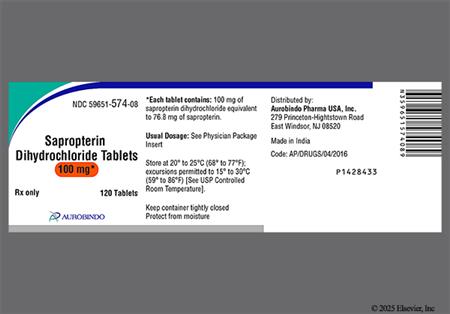
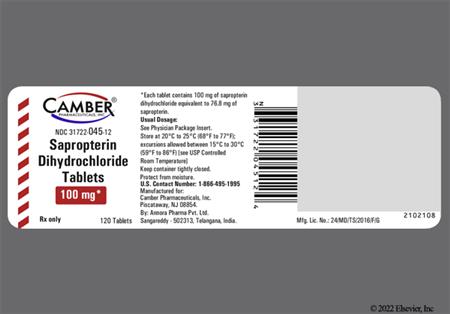
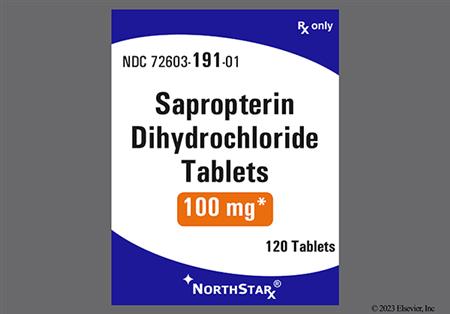
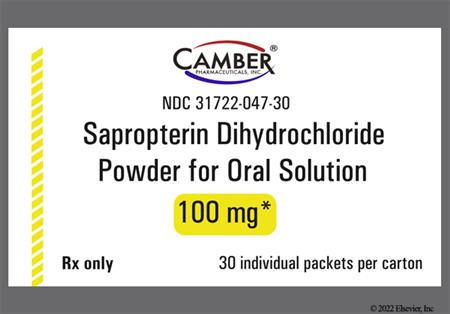
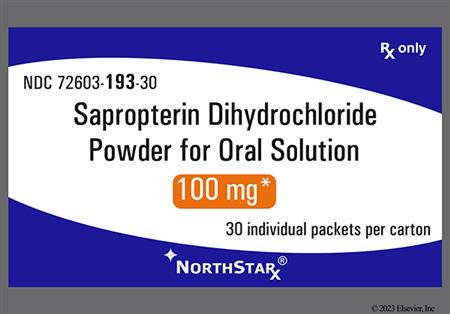
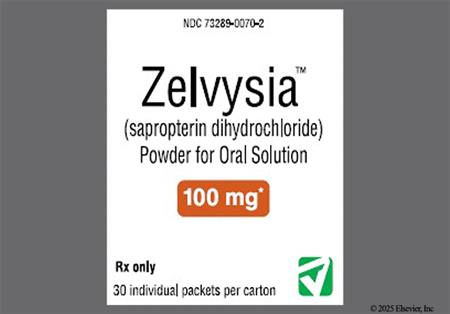
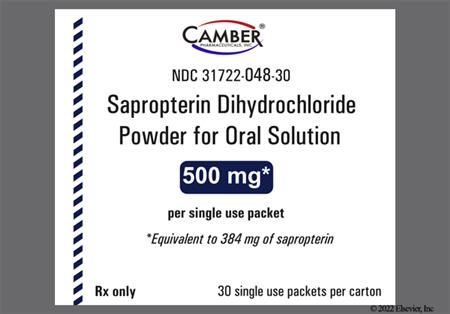
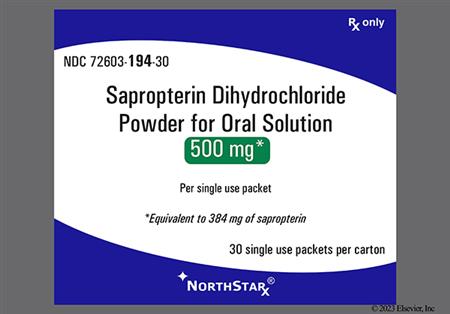
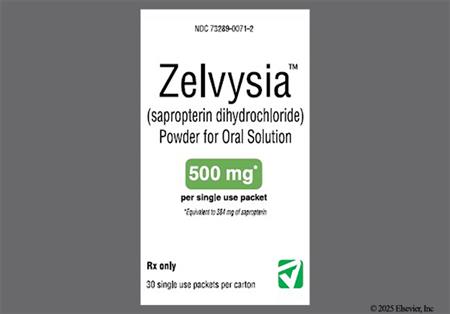
Sapropterin is indicated in conjunction with a phenylalanine-restricted diet to reduce blood phenylalanine concentrations in patients with hyperphenylalaninemia due to tetrahydrobiopterin- (BH4-) responsive phenylketonuria (PKU). Sapropterin is a synthetic form, 6R-BH4, of tetrahydrobiopterin and was the first FDA-approved drug to treat PKU. Phenylketonuria is a disease characterized by an increase in blood phenylalanine (Phe) concentrations. Increased blood Phe concentrations are caused by a genetic defect in the enzyme phenylalanine hydroxylase (PAH). PAH converts phenylalanine to tyrosine in the liver. Tetrahydrobiopterin acts as a cofactor to PAH in that reaction. It has been noted that PAH remains active in some patients with PKU. A trial of sapropterin is necessary to indicate patients that will respond to treatment. Even in patients who respond, the use of sapropterin does not eliminate the need for ongoing dietary management or for blood Phe concentration monitoring. Elevated blood Phe concentrations can cause severe neurological damage. Conversely, prolonged blood Phe concentrations that are too low may lead to catabolism and protein breakdown. A patient and physician support program is available; more information about this program is available at 1-877-695-8826.
For storage information, see the specific product information within the How Supplied section.
Oral tablets
Powder for oral solution
Patients weighing more than 10 kg:
Infants weighing 10 kg or less:
Making oral solution for 10 mg/kg/day dosing:
Making oral solution for 20 mg/kg/day dosing:
In clinical studies, sapropterin was administered to 579 patients with phenylketonuria in doses ranging from 5 to 20 mg/kg/day for lengths of treatment ranging from 1 to 164 weeks in patients ranging from 4 to 50 years of age. Among the most common adverse events reported in this trial and similar placebo-controlled trials were headache (15% vs. 14%), rhinorrhea (11% vs. 0%), pharyngolaryngeal pain (10% vs. 2%), cough (7% vs. 5%), and nasal congestion (4% vs. 0%). Rhinitis was infrequently reported, with 2 patients (7.4%) reporting this side effect in a study of 27 pediatric patients 0 to 4 years (n = 27). Post-marketing, oropharyngeal pain and pharyngitis were also reported.[33635]
In clinical evaluation of sapropterin, gastrointestinal related adverse events reported relative to placebo include diarrhea (8% vs. 5%) and vomiting (8% vs. 7%). Postmarketing, esophagitis, oropharyngeal pain, pharyngitis, esophageal pain, gastritis, dyspepsia, abdominal pain, nausea, and vomiting have been reported. If left untreated, esophageal stricture, esophageal ulcer, gastric ulcer, and bleeding have occurred. Monitor patients for signs and symptoms of upper GI mucosal inflammation.[33635]
Severe hypersensitivity reactions, including anaphylactoid reactions and rash (unspecified) have occurred during sapropterin administration. Signs of anaphylaxis include wheezing, dyspnea, coughing, hypotension, flushing, nausea, and rash. Discontinue sapropterin immediately and initiate appropriate medical treatment if anaphylaxis is suspected. Continue dietary Phe restrictions in patients who experience anaphylaxis. Post-marketing, most reported hypersensitivity reactions occurred within several days of initiating treatment.[33635]
In the post-marketing safety surveillance program for phenylketonuria (PKU), 2 patients experienced hyperactivity with administration of sapropterin. One case occurred in a patient who received an accidental overdose of the drug. Monitor patients for hyperactivity.[33635] In other safety evaluation among 800 healthy volunteers and patients with disorders other than PKU (some with underlaying neurological or cardiovascular disorders), sapropterin was administered as different formulations at doses ranging from 1—100 mg/kg/day for lengths of exposure from 1 day to 2 years. Serious and severe adverse nervous system reactions (regardless of causality) during sapropterin administration included seizures, exacerbation of convulsions, dizziness, headache, irritability, and overstimulation. Common adverse reactions reported were headache, agitation, and dizziness.[33635]
In other safety evaluation among 800 healthy volunteers and patients with disorders other than phenylketonuria (some with underlaying neurological or cardiovascular disorders), sapropterin was administered as different formulations at doses ranging from 1 to 100 mg/kg/day for lengths of exposure from 1 day to 2 years. Serious and severe adverse reactions (regardless of causality) during sapropterin administration included post-procedural bleeding, GI bleeding, myocardial infarction, and respiratory failure. Common adverse reactions were peripheral edema, arthralgia, polyuria, nausea, pharyngitis, abdominal pain, upper abdominal pain, and upper respiratory tract infection.[33635]
Hypophenylalaninemia (low blood phenylalanine [Phe]) has been reported with sapropterin treatment during clinical trials. In a clinical study of pediatric patients younger than 7 years receiving sapropterin 20 mg/kg/day, the incidence of hypophenylalaninemia was 25%, which was higher than in clinical trials of older patients. Prolonged low blood Phe concentrations have been associated with catabolism and endogenous protein breakdown, which has been associated with adverse developmental outcomes. Monitor blood Phe concentrations during treatment and if needed, modify the dosage of sapropterin and/or dietary protein and Phe intake to ensure adequate blood Phe concentration control. Frequent blood Phe monitoring is particularly recommended in the pediatric population.[33635]
The coadministration of certain medications may lead to harm and require avoidance or therapy modification; review all drug interactions prior to concomitant use of other medications.
This medication is contraindicated in patients with a history of hypersensitivity to it or any of its components.
There are insufficient data to assess the presence of sapropterin in human milk and no data on the effects on milk production. In postmarketing pregnancy registries, 13 infants were exposed to sapropterin through breast-feeding. No lactation-related safety concerns were reported in infants of mothers nursing during maternal treatment with sapropterin. There are no data on the effects on milk production. Sapropterin is present in the milk of lactating rats following intravenous administration, but not following oral administration. The developmental and health benefits of breast-feeding should be considered along with the mother's clinical need for the drug and any potential adverse effects on the breastfed child from the drug or from the underlying maternal condition.[33635]
There is a pregnancy exposure registry that has been established that monitors pregnancy outcomes in women who are exposed to sapropterin during pregnancy. For more information regarding the registry program, call 1-800-983-4587. Available data from pregnancy safety studies, pharmacovigilance, and published case reports with sapropterin use during pregnancy have not identified a drug-associated risk of major birth defects, miscarriage, or adverse maternal or fetal outcomes. An embryo-fetal development study with sapropterin dihydrochloride in rats using oral doses up to 3 times the maximum recommended human dose (MRHD) given during the period of organogenesis showed no effects. In a rabbit study using oral administration of sapropterin dihydrochloride during the period of organogenesis, a rare defect, holoprosencephaly, was noted at 10 times the MRHD. Uncontrolled blood phenylalanine concentrations before and during pregnancy are associated with an increased risk of adverse pregnancy outcomes and fetal adverse effects. To reduce the risk of hyperphenylalaninemia-induced fetal adverse effects, blood phenylalanine concentrations should be maintained between 120 and 360 micromol/L during pregnancy and during the 3 months before conception. Available data from the Maternal Phenylketonuria Collaborative Study on 468 pregnancies and 331 live births in PKU-affected women demonstrated that uncontrolled Phe levels above 600 micromol/L are associated with a very high incidence of neurological, cardiac, facial dysmorphism, and growth anomalies. Control of blood phenylalanine (Phe) during pregnancy is essential to reduce the incidence of Phe-induced teratogenic effects. Available data from pregnancy sub-registries within the Phenylketonuria Developmental Outcomes and Safety (PKUDOS) Registry and the Kuvan Adult Maternal Pediatric European Registry (KAMPER) have identified 72 live births (79 pregnancies) in women with phenylketonuria (PKU) exposed to sapropterin during pregnancy. Three birth defects were reported, including one case each of microcephaly, cleft palate, and tongue tie. The two major birth defects (microcephaly and cleft palate) were associated with Phe levels greater than 360 micromol/L.[33635]
Mechanism of Action: Sapropterin is a biologically active synthetic form of the naturally occurring enzyme cofactor tetrahydrobiopterin (BH4). Endogenous BH4 is a cofactor in multiple reactions including serving as a catalyst to phenylalanine hydroxylase (PAH) in the hydroxylation of phenylalanine (Phe) to tyrosine. Patients with phenylketonuria (PKU) have genetic mutations that result in deficient production or activity of PAH, which causes an increase in blood Phe concentrations. Over 500 mutations have been identified with considerable variability in the amount of residual PAH activity. Mutation severity is graded on the degree of PAH impairment. Severity of mutation does not accurately predict for responsiveness to BH4, only a trial of BH4 or sapropterin can determine responsiveness. Patients with PKU do not have an inherent deficiency in BH4 production or regeneration; however, increasing available BH4 has been shown to decrease blood Phe concentrations. The precise mechanism for this is unknown. One possible mechanism is that mutant PAH may require additional BH4 cofactor. Increasing available BH4 allows additional binding to PAH. Another possible mechanism is that BH4 exhibits a protective effect on mutant PAH. BH4 may increase the half-life of mutant PAH by preventing misfolding, which is a common PAH mutation.
BH4 is also a cofactor in the hydroxylation of tyrosine to L-DOPA and of tryptophan to serotonin. Adverse reactions from BH4 supplementation may be a result of these pathways (see Adverse Reactions). Increased BH4 concentrations may lead to an increase in L-DOPA and serotonin.
Revision Date: 08/12/2025, 04:09:43 PMSapropterin is administered orally. Sapropterin is a synthetic form of tetrahydrobiopterin (BH4) and is expected to be metabolized and recycled by the same endogenous enzymes (dihydrofolate reductase and dihydropteridine reductase). The elimination half-life of sapropterin in patients with phenylketonuria (PKU) is approximately 6.7 hours (range 3.9 to 17 hours). Population pharmacokinetic analysis of sapropterin in patients 1 month to 49 years of age showed that body weight is the only covariate substantially affecting clearance or volume of distribution.[33635]
Mean CL/F (L/hour/kg) +/- SD (Median) by age:
0 to less than 1 year: 81.5 +/- 92.4 (53.6)
1 to less than 6 years: 50.7 +/- 20.1 (48.4)
6 to 11 years: 51.7 +/- 21.9 (47.4)
12 to 17 years: 39.2 +/- 9.3 (38.3)
18 years or more: 37.9 +/- 20.2 (31.8)
Affected Cytochrome P450 (CYP450) isoenzymes and drug transporters: BCRP
In healthy subjects, administration of a single dose of sapropterin 20 mg/kg had no effect on the pharmacokinetics of a single dose of digoxin (P-gp substrate) administered concomitantly. Based on in vitro studies, sapropterin does not inhibit CYP 1A2, 2B6, 2C8, 2C9, 2C19, 2D6, or 3A4/5, nor induce CYP 1A2, 2B6, or 3A4/5. In vitro sapropterin did not inhibit OAT1, OAT3, OCT2, MATE1, and MATE2-K transporters. The potential to inhibit OATP1B1 and OATP1B3 has not been adequately studied. In vitro, sapropterin inhibits breast cancer resistance protein (BCRP), but the potential for a clinically significant increase in systemic exposure of BCRP substrates by sapropterin appears to be low.[33635]
To increase absorption, sapropterin should be administered with food. Administration after a high-fat/high-calorie meal caused mean increases of 84% in Cmax and 87% in AUC; however, extensive variability was noted across administration modes and meal conditions.
In a study of 88 patients with PKU not on phenylalanine (Phe)-restricted diets previously determined to have tetrahydrobiopterin (BH4)-responsive disease, a mean decrease in blood Phe concentration from baseline of 236 micromol/L was seen at 6 weeks with sapropterin 10 mg/kg/day compared to a 3 micromol/L increase over the same time period with placebo. Responders in this trial showed significantly decreased blood Phe concentrations at the initial assessment after 1 week, and this benefit persisted throughout the 6 week trial.[33785] In patients who respond to sapropterin, blood Phe concentrations generally decrease within 24 hours of a single dose of sapropterin. Maximum effect may take up to 4 weeks. A trial of 80 patients with a known response to sapropterin was conducted in which patients were titrated in two-week intervals through three separate dose levels. Blood Phe concentrations measured after each two-week course reflected a more pronounced response with increased dosage. Decreases in blood Phe concentrations from baseline at 5, 10, and 20 mg/kg/day were 100, 204, and 263 micromol/L, respectively.
Patients with liver impairment have not been evaluated in clinical trials. Monitor liver function tests because hepatic damage has been associated with impaired Phe metabolism. It is not clear if liver function affects the pharmacokinetics of sapropterin; use caution and monitor Phe closely.[33635]
Patients with renal impairment have not been evaluated in clinical trials.[33635]
Children and infants exhibit faster sapropterin clearance than adolescents or adults. Infants (younger than 1 year) have a mean clearance over twice as fast as that of adults (81.5 L/hour/kg vs. 37.9 L/hour/kg).[33635]
The pharmacokinetics of sapropterin in patients older than 49 years of age have not been studied.[33635]
There are insufficient data to assess the presence of sapropterin in human milk and no data on the effects on milk production. In postmarketing pregnancy registries, 13 infants were exposed to sapropterin through breast-feeding. No lactation-related safety concerns were reported in infants of mothers nursing during maternal treatment with sapropterin. There are no data on the effects on milk production. Sapropterin is present in the milk of lactating rats following intravenous administration, but not following oral administration. The developmental and health benefits of breast-feeding should be considered along with the mother's clinical need for the drug and any potential adverse effects on the breastfed child from the drug or from the underlying maternal condition.[33635]
There is a pregnancy exposure registry that has been established that monitors pregnancy outcomes in women who are exposed to sapropterin during pregnancy. For more information regarding the registry program, call 1-800-983-4587. Available data from pregnancy safety studies, pharmacovigilance, and published case reports with sapropterin use during pregnancy have not identified a drug-associated risk of major birth defects, miscarriage, or adverse maternal or fetal outcomes. An embryo-fetal development study with sapropterin dihydrochloride in rats using oral doses up to 3 times the maximum recommended human dose (MRHD) given during the period of organogenesis showed no effects. In a rabbit study using oral administration of sapropterin dihydrochloride during the period of organogenesis, a rare defect, holoprosencephaly, was noted at 10 times the MRHD. Uncontrolled blood phenylalanine concentrations before and during pregnancy are associated with an increased risk of adverse pregnancy outcomes and fetal adverse effects. To reduce the risk of hyperphenylalaninemia-induced fetal adverse effects, blood phenylalanine concentrations should be maintained between 120 and 360 micromol/L during pregnancy and during the 3 months before conception. Available data from the Maternal Phenylketonuria Collaborative Study on 468 pregnancies and 331 live births in PKU-affected women demonstrated that uncontrolled Phe levels above 600 micromol/L are associated with a very high incidence of neurological, cardiac, facial dysmorphism, and growth anomalies. Control of blood phenylalanine (Phe) during pregnancy is essential to reduce the incidence of Phe-induced teratogenic effects. Available data from pregnancy sub-registries within the Phenylketonuria Developmental Outcomes and Safety (PKUDOS) Registry and the Kuvan Adult Maternal Pediatric European Registry (KAMPER) have identified 72 live births (79 pregnancies) in women with phenylketonuria (PKU) exposed to sapropterin during pregnancy. Three birth defects were reported, including one case each of microcephaly, cleft palate, and tongue tie. The two major birth defects (microcephaly and cleft palate) were associated with Phe levels greater than 360 micromol/L.[33635]
Cookies are used by this site. To decline or learn more, visit our cookie notice.
Copyright © 2025 Elsevier, its licensors, and contributors. All rights are reserved, including those for text and data mining, AI training, and similar technologies.